Even the humblest of chairs represent an investment, and if you’re going to spend money on a piece of furniture, you want it to last as long as possible and look great for the entire time you own it.
In this article, we’ll provide you with cleaning tips on a wide range of furniture types. Note that although the title of this piece is ‘How to Clean Chairs,’ naturally, the advice here applies to pretty much any kind of furniture you might buy, from sofas, loveseats, sectionals, and the like.
Spills and stains are inevitable. They’re a fact of life, and the longer you own a given piece of furniture, the more accidents you’ll have to contend with. In the sections below, we’ve broken down and alphabetized furniture by the dominant material they’re made of. If you’re looking for cleaning tips on wicker furniture, you can simply skip ahead to that section to save time.
How to Clean Leather Chairs
✅ Also answered in this section:
➡️ How To Clean White Leather Chairs
The best way to clean minor stains on a piece of leather furniture is soap and water. Note, however, that we’re not talking about the soap you shower with. Various companies make Saddle Soap, which is the type of soap you’ll want to use.
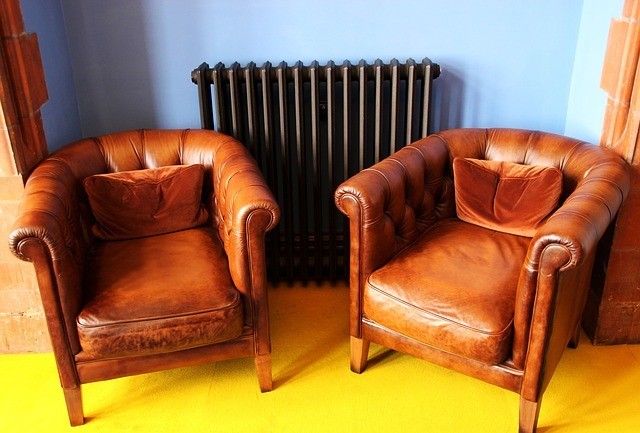
Simply fill a bowl with lukewarm water, lather your saddle soap into a damp washcloth and rub gently with the grain of the leather to wipe the stain away, then wipe the area dry with a soft cloth.
For deeper, darker stains, dipping a cotton swab into rubbing alcohol will, in most cases, remove the stain. Note that this is fairly precise work, though. You only want the rubbing alcohol to touch the stained area of the leather.
Discoloration may result if it spreads to other areas, so great care must be taken when using this approach.
In terms of maintenance, periodically dust your leather furniture with a soft cloth and apply leather cream every month to keep the material supple and maximize its comfort and longevity.
How To Clean Metal Chairs
✅ Also answered in this section:
➡️ How to Clean Aluminum Chairs
➡️ How to Clean Iron Chairs
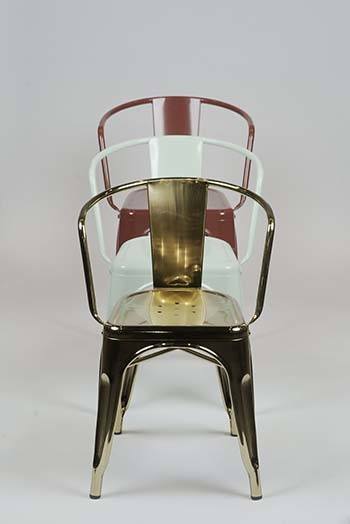
Oxidation is the biggest danger where metal furniture is concerned, and the process of cleaning chairs made of metal of any kind is a bit more involved than cleaning furniture made from other materials.
To begin, remove as much oxidation you can via a 1:1 mixture of vinegar and water, or a metal polishing paste. Be sure to avoid any type of alkaline cleaners as these cause oxidation and will only make your problem worse.
In the case of aluminum furniture, in particular, you can remove minor scuff marks with a soft cloth and a bit of non-abrasive cleaner like Soft Scrub.
If you’ve let oxidation build up on your metal furniture to the point that rust has started to form, gently sand it. Any damaged paint there might be off, wipe the freshly sanded metal with a cloth, dampened with naphtha or mineral spirits. Before repainting with rust-resistant paint, be sure to put down a coat of rust-resistant primer.
If you have wrought iron furniture, have it powder coated or sandblasted to provide an additional layer of protection from the elements.
Automotive wax applied to your metal furniture (two coats for iron furniture, one coat for aluminum, or other metals) will help protect your investment once you’ve finished cleaning.
How to Clean Patio Chairs

Since there’s no one ‘type’ of patio chair, we can’t provide concise cleaning instructions for this category. Instead, we refer you to the materials section that provides the best match for the material your patio furniture is made from.
If you don’t see your furniture’s material listed in this document, we encourage you to leave a comment for us below, letting us know what your furniture is made of and we’ll add a section on cleaning that type of furniture!
How to Clean Plastic Chairs
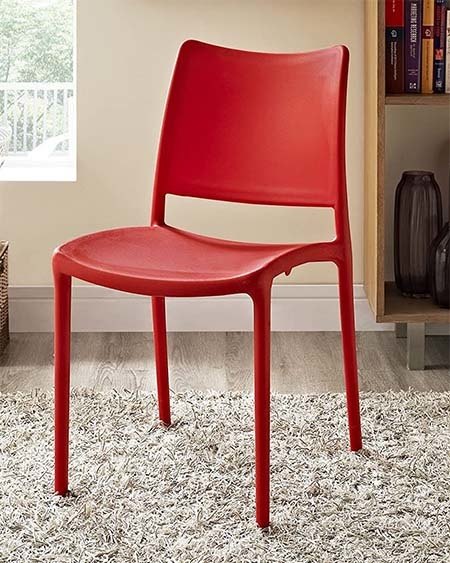
✅ Also answered in this section:
➡️ How To Clean Chalky Plastic Lawn Chairs
➡️ How To Clean Outdoor Plastic Chairs
➡️ How To Clean Plastic Lawn Chairs
➡️ How To Clean White Plastic Chairs.
➡️ How To Clean White Plastic Lawn Chairs.
This one is about as simple as it gets. Even if you’re using your plastic furniture indoors, you can take them outside for a cleaning. Simply mix generous amounts of dish soap and hot water into a large bucket and grab a sponge.
Soak the chair thoroughly and allow the soapy water to sit for ten to fifteen minutes before wiping the chair down completely, scrubbing vigorously on stained areas until the stain has been removed.
After that, hose the chair down with your garden hose and wipe dry with a soft cloth. Allow to air-dry overnight before using the furniture or bringing it back indoors if that’s where you use it primarily.
If you have white plastic furniture and you’re dealing with particularly deep stains, you can add a few drops of bleach to your cleaning solution. If you go this route, moderation is the key!
Add too much bleach, and the fumes will be overwhelming, not to mention the fact that bleach in high concentrations will eat away at plastic, so you need to be careful not to add very much.
How to Clean Oxidized Plastic Patio Chairs
Oxidation inevitably occurs when you leave furniture outdoors for an extended period. It causes the surface layer of the plastic to become discolored and hazy. Fortunately, it’s an easy thing to remedy, so long as you stay on top of your maintenance duties.
If you give the chair in question a thorough cleaning using the steps we’ll outline below, you can stop it in its tracks and restore the chair to its former shine and glory.

Start with a bucket of hot soapy water, using dish soap or other mild detergents. Give the chair a thorough soak and allow the detergent to sit on it for ten to fifteen minutes. Then scrub the chair with a soft-bristled brush, focusing on the areas of oxidation and other stained areas.
Rinse with a garden hose and towel dry, leaving the chair to sit overnight so that it dries completely. After that, apply car or boat polish to a clean rag and rub it into the oxidized areas. Buff until the hazy areas on the chair return to their original shine.
How to Clean Resin Chairs
There are three good DIY cleaning recipes you can use for resin chairs. All three are comparable in terms of their effectiveness, so which one you use ultimately comes down to personal preference. We’ll present all three, so you’ve got plenty of options to choose from:
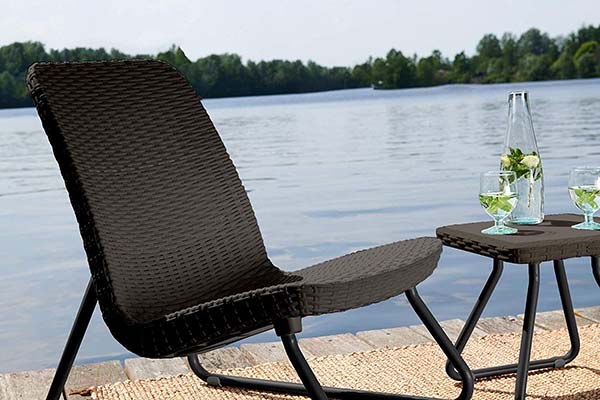
Whichever recipe you decide to use, soak a sponge or rag in the cleaner of your choice and scrub the chair thoroughly.
If you encounter a stain that the cleaners above could not remove, break out some white, distilled vinegar, dab a clean rag into it and scrub the stain vigorously with that.
If that still doesn’t do it, dampen a sponge and sprinkle a bit of baking soda on it, scrubbing the stain again. This gives you a very mild abrasive that should get the job done without actually scratching the plastic.
Once you’ve dealt with all of the stains, hose the chair off and towel dry it. If the shine has come off of the chair, spray a bit of WD-40 on it and wipe the resin clean to make it look like new, then finish your detailing by applying a coat of auto wax to protect it. Let that dry completely, and the chair is ready to use again!
How to Clean Suede Chairs
Suede has a reputation for being a finicky, hard to clean material. It looks great, it feels great, but it can be challenging to keep it looking great. Unlike the other types of furniture we’ve talked about, which you can clean with basic household supplies you’ve got on hand, cleaning suede requires fairly specialized cleaners.
The first and most important thing to say is this: If your suede chair or sofa came with specific instructions for cleaning drafted by the manufacturer, by all means, consider those instructions to be the gospel truth.
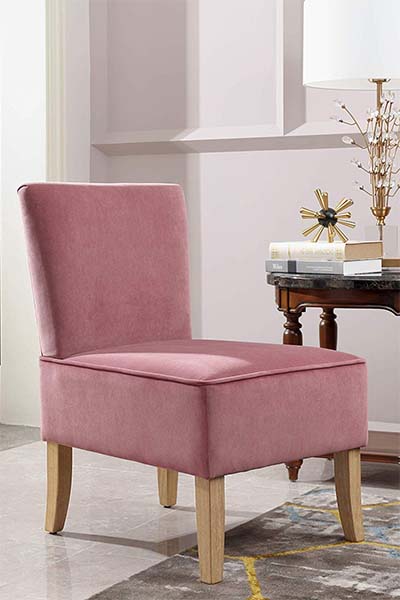
Second, you’ll find that a suede brush and a powerful hand vacuum are your best friends when it comes to handling general cleaning duties. To keep your suede furniture looking like new, you should commit to vacuuming and brushing every week.
When dealing with stains, though, those two items simply aren’t going to be enough. You’ll need a suede cleaning spray, your suede napping brush, and a suede rubbing cloth.
If you’ve never used the suede cleaner you’re trying out, always start by spraying a small amount on a largely unseen area of your piece of furniture to confirm that it won’t discolor or otherwise impact the material.
Once you’ve verified that, spray the stained area with your chosen suede cleaner, then brush vigorously to remove the stain.
Then, spray the entire piece of furniture with a suede-friendly stain repellant and rub it into the furniture with your suede cloth.
If you’re dealing with a liquid stain on your suede furniture and the suede-friendly cleaner is proving insufficient to the task of dealing with it, moisten a clean cloth in white vinegar and rub the affected area in small circular motions. Allow to dry completely and then brush the stained area with your napping brush.
For grease stains, sprinkle cornstarch or talcum powder on the greasy area and allow it to sit overnight to give it time to soak up the grease, then vacuum it off of the furniture the following day, brushing as a final step.
How to Clean Upholstered Chairs
✅ Also answered in this section:
➡️ How To Clean Cloth Chairs
➡️ How To Clean Fabric Chairs
➡️ How To Clean Fabric Dining Chairs
➡️ How To Clean Upholstered Dining Chairs
➡️ How To Clean Upholstery Chairs
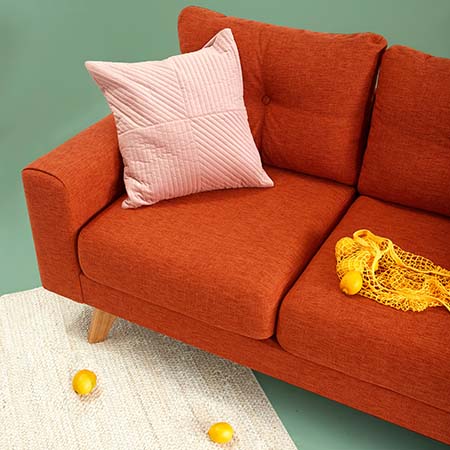
There is a staggering variety of fabric options where upholstered chairs are concerned, and as such, the first place you should turn to for cleaning advice is the manufacturer you purchased the chair from. If they offer cleaning instructions, follow them to the letter for optimal results.
Bear in mind too that some furniture comes bearing tags that provide helpful, if cryptic cleaning hints.
If there are no manufacturer cleaning instructions to be found, the strategies below will serve you well enough in their place.
Where fabrics are concerned, your two best pieces of equipment are a powerful hand vac and a lint roller. These should be employed weekly for general clean up duties that will keep your furniture looking great for the long term.
In addition to that, if you have pets, or if you notice that for any reason, your chair has picked up an unpleasant odor, Febreze and other companies make fabric restoring sprays that will kill unpleasant odors, and in a few cases, offer at least some protection against future stains.
Where liquid spills are concerned, start by blotting the liquid up with a soft cloth. Don’t scrub or rub the spill! All you’ll accomplish by doing that is grinding the dyes in the liquid into the fabric and make it more difficult to completely clean.
Once you’ve blotted the liquid spill, mix a solution of dish soap and warm water (1/4 cup of dish soap, mixed with a cup of water). Agitate until foamy and dab soapy water into the stained area. Again, take care not to rub or scrub! Pat dry with a separate soft cloth and let it breathe for at least 12 hours before sitting on the wet spot to allow it to dry completely.
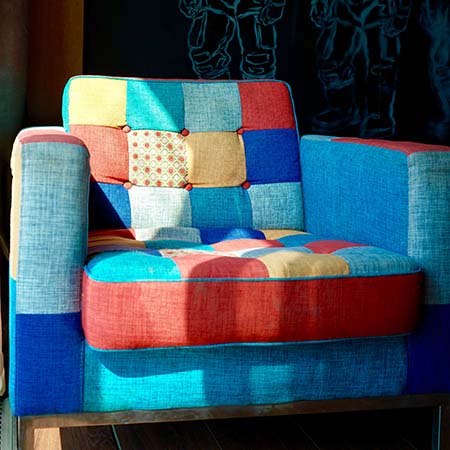
If you’re looking for something a bit stronger, you can use the 3% hydrogen peroxide you probably have in your bathroom. If you have hydrogen peroxide that’s stronger than 3%, dilute it with water to reduce its strength before using.
ALWAYS spot test your cleaning solution in a hard-to-see area of the chair in case it winds up discoloring the fabric.
Once you’ve confirmed that the solution is safe to use, blot it onto the stained area, let it sit for a minute or two, and then blot it back up with a dry cloth, letting dry overnight before using the chair again.
For an even stronger solution, mix two parts water with one-part white vinegar into a spray bottle. Shake well to thoroughly mix and spray the solution onto the stained area, then gently scrub the stained area in a circular motion. As before, let sit for 24 hours to allow the fabric to dry completely before sitting in the chair again.
If your fabric-upholstered chair has a “W” sticker on it, indicating that water-based cleaning solutions are okay, you can also steam clean the fabric to tackle deep, pervasive stains, but this is a major (and fairly time and labor-intensive) undertaking that should be reserved for the most serious stains.
How to Clean Wooden Chairs
✅ Also answered in this section:
➡️ How To Clean Wood Chairs
A soft, dry cloth and regular wipe downs are your first line of defense against dirt and minor stains where wood and wicker furniture are concerned. Once a month, there’s just no substitute for Murphy Oil Soap and warm water, but if you want to try a DIY recipe, this will work fairly well:
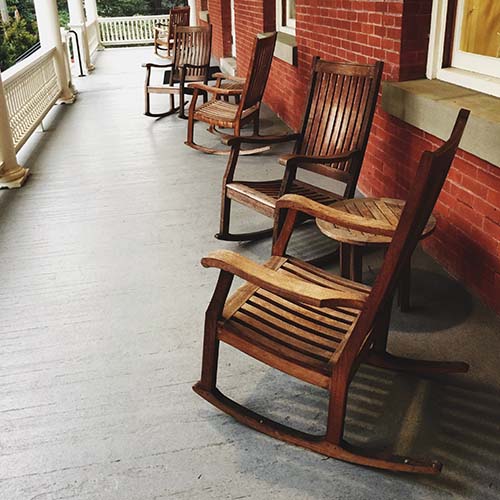
Dampen a cloth in this solution and wipe the chair down, scrubbing stained spots away, then towel dry and let sit overnight before using the chair again.
If you have hardwood furniture, Murphy Oil soap and water will certainly help clean and preserve your furniture, but there are several other commercial products (sprays and liquids) that will not only help keep it looking like new but will also provide a measure of protection against stains, dents, dings, and scratches.
Ultimately though, sanding and re-staining, then laying down a couple of fresh coats of polyurethane are your best bets to keep hardwood furniture looking like new for years or even decades. While some sites online recommend doing this on an annual basis, in our view, this is serious overkill. With reasonable care, you can probably get away with doing it every 8-12 years.
How to Clean Wicker Chairs
All the same strategies used to clean wood furniture apply to wicker furniture, but you’ll want to dilute your cleaning solution so that it’s about half the strength of what you’d use on wood (keep the amount of water the same, but use half of any cleansing agent mentioned in the section on wood).
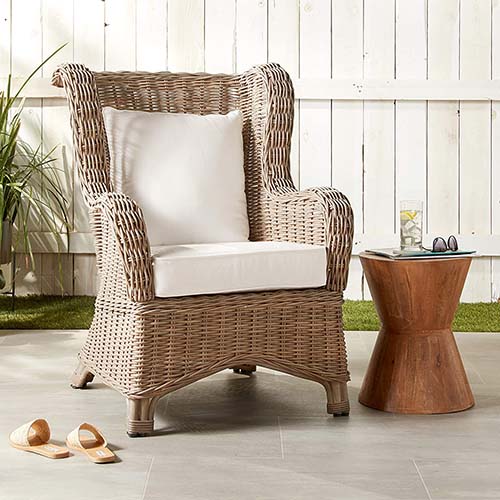
How to Clean Vinyl Chairs
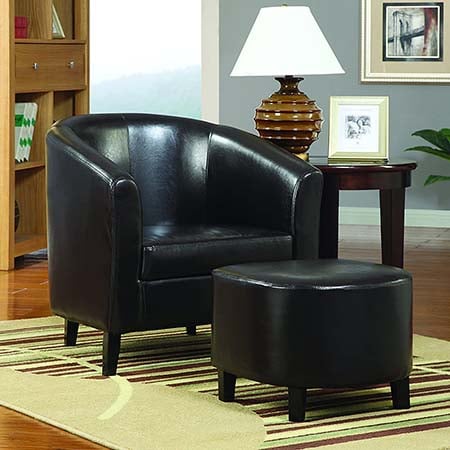
Vinyl may look like leather, but definitely don’t try to clean it using the same strategies you’d use to clean leather!
Again, your trusty hand vac is your first line of defense in terms of picking up loose debris, and all you really need to clean most stains from vinyl is a damp washcloth.
If you need more cleaning power, mix a small amount of dish soap with warm water, dampen your rag and rub in a gentle, circular pattern on the stained area.
It’s important to remember that vinyl isn’t nearly as rugged or durable as leather, so you’ve got to take it easy on the material when cleaning. Go slow and be gentle. Yes, it will take longer to get deeper stains out, but better that it takes a bit more time than ruining the upholstery!
To get mildew off of soft vinyl furniture, mix one-part ammonia with four parts of water and dampen your cloth in that mixture, again, rubbing in a gentle circular motion. Never use anything abrasive on soft vinyl!
If you have a piece of furniture made from hard vinyl, you can treat it to the same cleaning strategies above, but you can also use baking soda to give yourself a bit of abrasion. Unlike soft vinyl, hard vinyl furniture can stand up to modest amounts of abrasion, so baking soda is fine for these purposes. Just sprinkle some on, dampen a cloth and rub gently. Hard vinyl can also be further protected by applying a coat of automobile wax once cleaning has been completed.
How to Clean Chairs Conclusion
Ultimately, there’s no such thing as a one size fits all, cookie-cutter solution that will keep your favorite chair looking great over the course of its life. It always comes down to what your chair is made of and upholstered with. If you try to mix and match, say, using the strategies to clean leather on some other type of upholstery, the results won’t be pretty.
The good news is that no matter what your favorite chair is made of or upholstered with, there are ways to clean it and help keep it looking like new. This mostly comes down to taking the time to clean your furniture regularly and avoid letting stains build up or set in over an extended period.
A light cleaning once a week, followed by a more thorough monthly cleaning and then attending to spills and accidents as they happen, will put you miles ahead of the game when it comes to keeping your furniture looking like new for as long as you own it.
As we mentioned at the start, if you own a piece of furniture made from, or upholstered with some material not covered here, just leave us a comment below, and we’ll add it to our list!